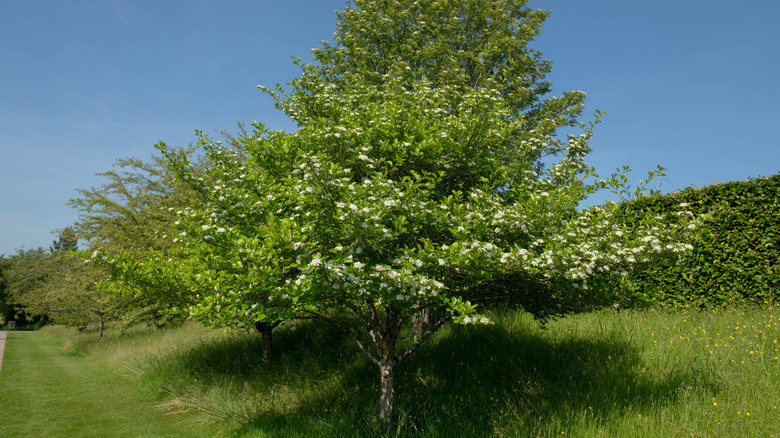Hawthorn Tree has become one the most consumed medicinal herbs in the world due to its systemic benefits to the human body. As demand has grown so has the knowledge to plant and grow this herbs in your own backyard.
Highlights
Deciduous hawthorn (Crataegus spp.) shrubs and trees are native to the temperate regions of the Northern Hemisphere. Its attractive appearance and ability to provide food and shelter for native animals have led to its widespread cultivation. Here is a quick rundown of some of the more pertinent information about Hawthorn bushes:
Hawthorn trees can grow to a height of 10–30 feet and a width of up to 40 feet. Some specimens have been found to be 200 years old or older, and they mature very slowly over the course of their long lives.
Hawthorn tree leaves are typically a vivid green, oval in form, and serrated at the edges. They turn brilliant shades of golden and orange in the fall and then fall from the tree on their own.
Flowers: In the spring, hawthorn trees produce clusters of fragrant white or pink flowers. These flowers attract a variety of beneficial insects that help spread pollen and nectar.

Following the withering of the tree’s flowers, clusters of tiny red, yellow, or black berries will form. These berries are great for making jellies, syrups, and even wines due to their sour flavor. As mentioned earlier Hawthorn berries have been used for centuries for their medicinal properties. Let us continue with the Hawthorn tree, a separate will follow regarding those benefits. The hawthorn tree has rough bark that is hard and grayish brown in hue.
Hawthorn trees do best in well-drained soil, but they can tolerate a wide range of environmental conditions.
Will hawthorn grow in shade?
Hawthorn, a plant native to the temperate zones of the Northern Hemisphere, can take the form of either a shrub or a small tree. It’s adaptable, so long as it gets plenty of sun, and it can thrive in a wide range of soil and climate conditions. Hawthorn may grow in partial shade, although its flower and fruit output may be reduced. Both the specific species and the level of shading affect how much shade a plant can tolerate. Choose a hawthorn kind that does well in low light if you plan to plant it in a shady area. The lower branches can be pruned lightly so that more light can reach the ground.
Where do hawthorn trees grow?
Throughout Europe, Asia, and North America, the hawthorn tree thrives in a wide variety of climates and soil types. These can be found all over the temperate parts of Europe, including the UK and Ireland. Native to both the American continents and East Asia (China, Korea, and Japan). These plants are so adaptable that they may survive in a wide range of conditions, from rocky or sandy soils to areas with moderate to heavy rainfall. They are light-tolerant, meaning they do well in either full sun or partial shade.
When do hawthorn berries appear?
Berries on hawthorn trees usually appear for the first time in late summer or early fall, typically in August and September but this can vary greatly by species and climate. Hawthorn bushes, a widespread type of shrub or small tree, are distinguished by clusters of red berries (haws). Both animals and humans enjoy them for their use in traditional herbal medicine and the health benefits they provide.
When do hawthorn trees bloom?
Hawthorn trees usually bloom in May or June, but flowering time can vary with latitude and species. The exact time of blooming can be affected by a number of factors, including climate, altitude, and local weather. Hawthorn trees produce fragrant clusters of white, pink, or crimson flowers that attract bees and butterflies.
When are hawthorn berries ripe?
The months of August and September are typically when hawthorn berries ripen, but this can vary depending on the variety and the climate. A few signs indicate when hawthorn berries are ready to be picked. The berries should be plump, full, and a vibrant crimson or orange, and they shouldn’t have to be pushed off the branch. Ideally, the fruit will be soft without being mushy. Overripe fruit, such as berries, may be dark in color and have begun to ferment, so it’s best to pick them when they’re at their peak of ripeness but still firm.
When does hawthorn flower?
The hawthorn, a deciduous shrub or small tree, is well-known for the white, pink, or red flowers it produces each spring. The actual period of flowering, however, might change from place to place and season to season. Hawthorn blossoms may make an early appearance in warmer climates, while those in cooler places may hold off until later in the spring.
Are hawthorn trees invasive?
Although hawthorn trees (genus Crataegus) are not typically considered invasive, they can spread and become established in locations where they are not indigenous. It’s crucial to be aware of the potential influence of the species of hawthorn you plant on your local ecology because some kinds are deemed invasive in particular locations and can displace native flora.
It is possible for hawthorn trees to establish thickets that stifle the development of other plants, which is especially problematic for native species. In addition, hawthorn fruits can be dispersed by birds, aiding the spread of the plants to new locations. If you want to plant a hawthorn tree but are worried about it spreading into unsuitable areas, you should go to a local nursery or botanical garden about which species are best suited to your region.
Originally published at www.theholisticmedic.net

